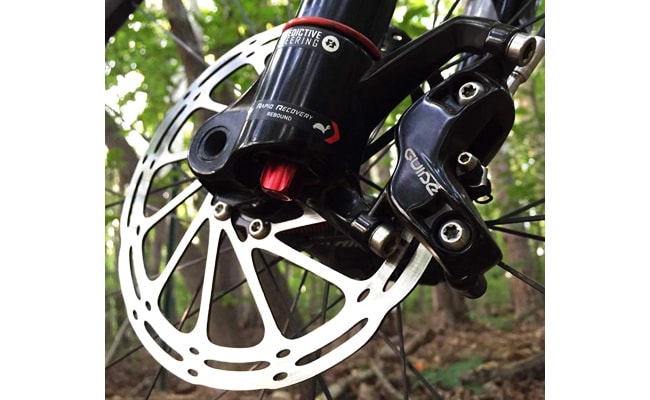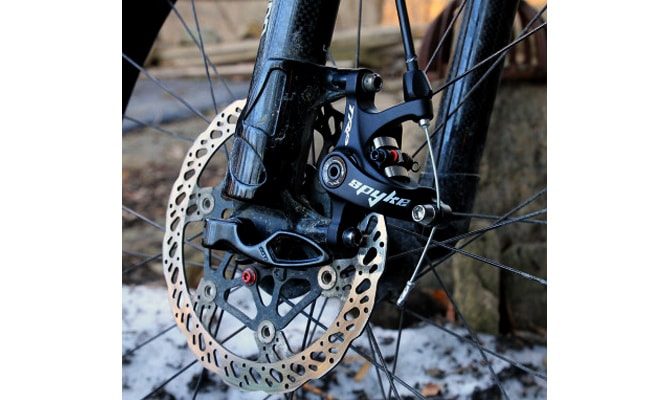As a cyclist, one thing you cannot escape is the inevitable development of technology within the cycling world.
Here’s what I mean.
The humble bicycle has over the years evolved, and choosing the right bike is today more challenging than ever. If you select the disc brake over the rim brake, you must also choose between the mechanical and hydraulic brakes.
From the time we have spent analyzing these two options, we can confidently conclude that the best brake highly depends on your needs, preferences, and budgets.
Dive in, and let’s make a detailed mountain bike hydraulic brakes vs. mechanical brakes comparison to help you make a well-informed choice.
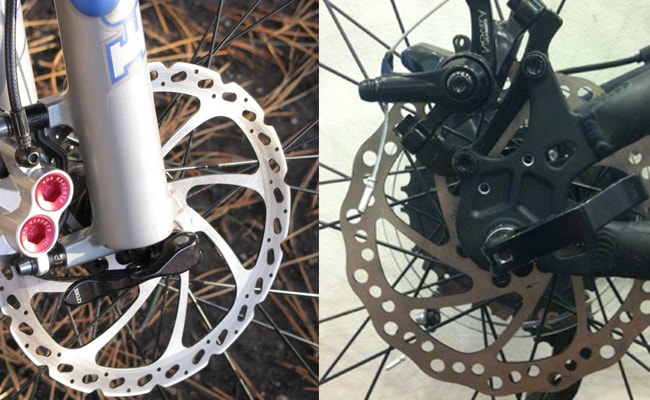
Difference Between Mountain Bike Hydraulic and Mechanical Brakes
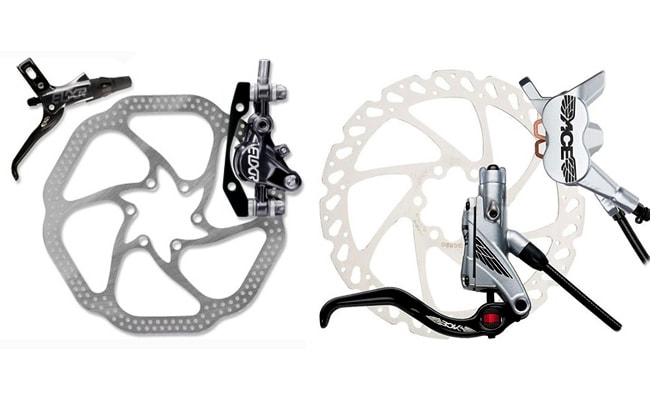
Bike brakes, in general, operate by a universal principle. The only difference is that while mechanical disc brakes are run by cable, hydraulic disc systems are run via the fluid. This fluid, however, operates in the same manner as a cable.
Let’s break down the common aspects of these two brake types.
How They Work
With hydraulic disc brakes, fluid is used to push the braking pads against the rotor, and this brings the bike to a halt.
Mechanical disc brakes, on the other hand, use a cable to pull the caliper down and this forces the pads against the rotor making the bicycle to stop.
How the Brakes Are Realigned
It is usual for the brake pads to need realigning from time to time. When they begin to wear out, the braking power of your bike is impacted because the pads shift further from the rotor, causing a squeaking noise.
When aligning the hydraulic disc brakes the correct procedure for the rear and front brakes are similar.
Start by loosening the mounting bolts without removing them and ensure the caliper body is flexible. Squeeze the brake lever and get the caliper body centered over the rotor before tightening the bolts.
Before you call it a wrap, spin the wheel and test whether the pads are rubbing against the rotor.
More adjustments are needed if you notice that the pads are still rubbing against the rotor. Just ensure you have space on either side between the pads and the rotor.
When realigning mechanical brakes, first get the rotor correctly positioned and inspect it. Ensure the lever arm is flexible before pulling the cable tight and fastening the pinch bolt.
You will notice that mechanical brakes have fewer pins, and this means more frequent realignment is needed.
Maintenance of Hydraulic Brakes Vs. Mechanical
When it comes to maintenance, hydraulic brakes are less demanding. You need to bleed your bike once or twice a year, depending on how frequently it is in use.
On the downside, upkeep chores can get a little frustrating because even a slight incorrect move can leave your rotors and brake pads ruined by brake fluid.
Bleeding the brakes is also an expensive affair if you hire a mechanic.
Mechanical brakes need more frequent upkeep, although the process is fortunately easy and fast. All you need to get the job done is an Allen key.
Unfortunately, you will not be able to fully use your brake pads if you fail to tweak and adjust your brakes regularly.
Disc Brake Benefits Mechanical Vs. Hydraulic
Benefits of Hydraulic Brakes:
The modulation of hydraulic brakes is without debate impressive. Cyclists are in total control of their stopping speed, and this promotes safety irrespective of the riding terrain or weather conditions.
Additionally, less effort is needed to stop, and all you need to do is use a finger to squeeze the brake lever.
Hydraulic brake systems are fully enclosed, and this reduces exposure to elements that can mess with their longevity.
Another perk that is hard to ignore is that the brakes are self-adjusting, and this means braking is smoother.
On the downside, fixing failed brakes on the go is nearly impossible.
Hydraulic brakes also tend to be more expensive than their mechanical counterparts.
Moreover, upkeep chores are technical and messy, and cyclists always face the risk of the oil boiling, especially when going down long descents.
Benefits of Mechanical Brakes:
The most notable benefit of mechanical brakes is that maintenance chores are easy. These brakes are also less expensive, and you only need to get the cables and pads replaced.
In case an issue arises while on the road, you can fix it with ease as long as you have your Allen key.
It is worth mentioning that mechanical brakes function more efficiently. A tension steel cable gets the pistons activated, and this compresses the brake pads against the rotor.
Mechanical brakes offer lesser modulation, especially when riding in poor conditions.
There is more friction within the brakes housing, and this, coupled with the fact that the system is exposed to dirt and debris, can cause untimely breakdowns.
You may also want to know that the cables stretch over time.
Comfort and Feel Comparison
When you squeeze the lever of your hydraulic brakes, you will instantly notice that the braking motion is quite smooth.
The feel of strength and modulation is also better, and this should increase your confidence when riding down a hill.
When you squeeze the brake lever of your mechanical brakes, you will feel the cable in the housing, and this is not comfortable. In case you need to make emergency brakes, you must squeeze your brake lever harder.
Final Words
So which is the better option? Well, both are disc brakes only that one uses fluid and the other one uses cables.
Their pros and cons balance, so it’s a trade-off. From my point of view, you need to consider your mountain biking preferences and of course your financial means.
The advancements in both mechanical and hydraulic brakes have brought forth more benefits for cyclists. One of the most notable perks is more significant momentum on the hard-hitting roads.
Now that you understand the critical mountain bike hydraulic brakes vs. mechanical brakes differences, it should be easier to decide on the braking solution that best suits you.

13 Best Mountain Bike Brands of 2023
Before discussing the best mountain bike brands, you need to believe that cycling is never all about moving around on a flat ground with your

Mountain Bike Vs Road Bike: Which one is best for you?
When you are searching for that low impact form of exercise, cycling can be the most appropriate. It is embraced by both children, young and

The 8 Best Mountain Bikes Under $500
Your best companion on the mountain roads is your bicycle. Nothing can beat the feeling of speeding through the trees with your mountain bike. Budget
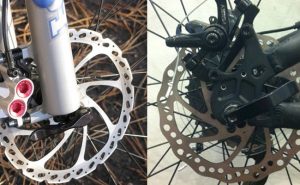
Mountain Bike Hydraulic Disk Brakes Vs Mechanical
As a cyclist, one thing you cannot escape is the inevitable development of technology within the cycling world. Here’s what I mean. The humble bicycle

10 Types of Mountain Bikes – Which One to Buy
Imagine going down a mountain so fast that everything around you is a blur, and all you can do is trust your instincts and paddle

Complete Mountain Bike Size Guide With Chart
Buying a mountain bike online can save you a substantial amount of money. However, people often get confused about which size to get as you

